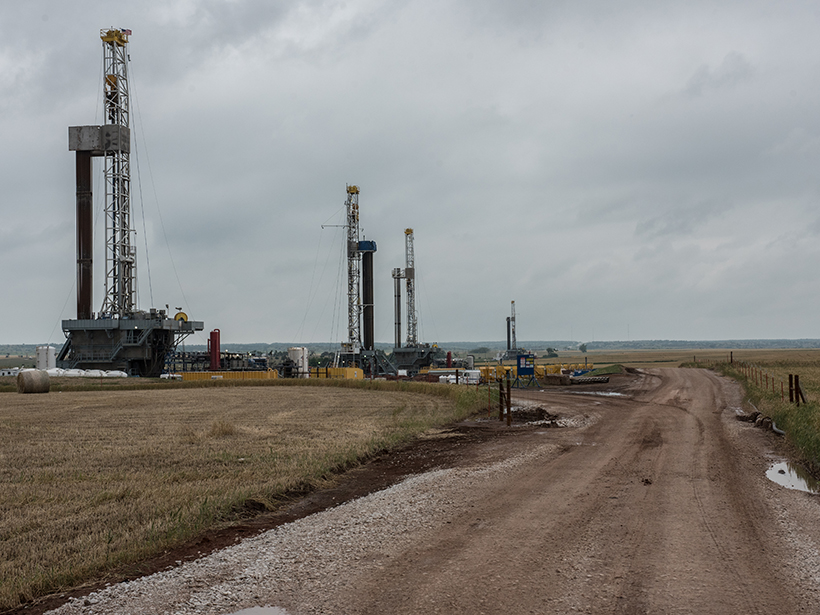The oil and gas industry’s practice of pumping wastewater fluids underground for disposal has been implicated in the dramatic uptick in earthquakes in the central United States. Now a new study has found a correlation between the increasing depth of the earthquakes and the rate at which these fluids descend through Earth’s crust, a finding that could have implications for how such fluids are regulated.

Over the past decade, earthquakes in the central United States greater than magnitude 3.0 have increased dramatically because of disposal of oil field wastewater into deep geologic formations. Injecting these fluids under pressure can destabilize faults and, in some places, trigger hundreds of induced earthquakes a year over magnitude 3.0, some as large as the magnitude 5.8 quake that struck Pawnee, Okla., in 2016.
Studying the mechanisms by which injected fluids trigger earthquakes has been hampered by a lack of accessible information about the compositions of the wastewater fluids, said Ryan Pollyea, a hydrogeologist at Virginia Polytechnic Institute and State University in Blacksburg and lead author of the new study, published in Nature Communications. “So much of that data is proprietary information, held by the oil and gas companies,” he said.
To assess how the density of the fluids may influence their descent, Pollyea and colleagues turned to a database maintained by the U.S. Geological Survey that includes typical compositions of wastewater fluids. Some of these fluids have very high dissolved salt content, Pollyea said, making the fluids denser and heavier than groundwater found in fault systems.
“This [study] provides compelling evidence that high-density wastewater is sinking and causing earthquakes to get deeper within the study areas.”
“We developed computer models showing that oil field wastewater tends to sink when it has a higher dissolved solids concentration—and thus, higher density—than fluids deep within the Earth’s crust,” he said. As this high-density wastewater sinks, it displaces the lower-density fluids that naturally reside in the faults and increases fluid pressure, potentially triggering fault movements.
The team also analyzed earthquake data collected across several Oklahoma counties and found that earthquakes are getting deeper at the same rate high-density wastewater sinks—by about half a kilometer a year. “This provides compelling evidence that high-density wastewater is sinking and causing earthquakes to get deeper within the study areas,” he said.
Earthquake data collected across a broad region of northern Oklahoma and southern Kansas between 2013 and 2018 have demonstrated that the overall earthquake rate has been declining since 2016. Pollyea and colleagues found that although that may be the case overall, the number of earthquakes over magnitude 4.0 is increasing in number. These larger quakes tend to strike at depths below 4 kilometers. “This is likely the result of wastewater sinking and driving up fluid pressure at greater depths,” he said.
Previous studies have not considered the role of wastewater fluid density on fault systems, said Shemin Ge, a hydrogeologist at the University of Colorado Boulder who was not involved in the new study. “In the past, we have generally thought of wastewater as just water. This study adds a new dimension: What happens when the wastewater is denser than water? How does it move through the Earth? It’s a very interesting new perspective.”
“We need more cooperation and collaboration from industry if we’re going to understand how these fluids interact with the fault environment.”
The new study also suggests that fluids pumped underground can trigger earthquakes for over a decade after pumping stops, Pollyea said, as the fluids continue to sink to depths beyond 8 kilometers. “Our models also show that high-density oil field wastewater will continue sinking and increasing fluid pressure for over a decade after disposal operations cease,” he said.
Going forward, both Pollyea and Ge would like to see more transparency from oil and gas companies about the contents of wastewater fluids. “The composition of these fluids and other pertinent information should be incorporated into the permitting and regulatory process,” Pollyea said. “If more of that data was available, we could learn a lot more about the mechanisms driving these earthquakes.”
“We need more cooperation and collaboration from industry if we’re going to understand how these fluids interact with the fault environment,” Ge said. “It’s surprising how little we know about [wastewater fluids] and yet they have such a significant impact on huge regions of the country, an impact that this study shows will not immediately go away after they stop injecting.”
—Mary Caperton Morton (@theblondecoyote), Science Writer
23 August 2019: The article was updated to correct and more fully explain the graphs.
Citation:
Morton, M. C. (2019), Sinking wastewater triggers deeper, stronger earthquakes, Eos, 100, https://doi.org/10.1029/2019EO130663. Published on 16 August 2019.
Text © 2019. The authors. CC BY-NC-ND 3.0
Except where otherwise noted, images are subject to copyright. Any reuse without express permission from the copyright owner is prohibited.

